Joshua Tree National Park - national park of the United States
Joshua Tree National Park is a United States National Park in the Southern California Desert. The park encompasses nearly of the Mojave and Colorado Deserts, conserving two separate desert ecosystems at different altitudes.
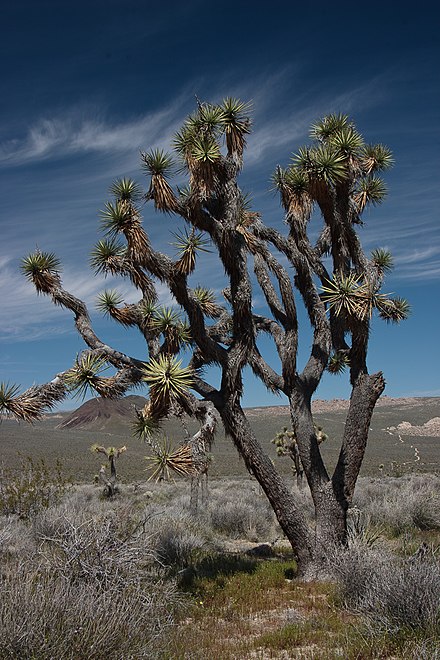


Understand
The name of the park is derived from the distinctive Joshua tree (Yucca brevifolia), a tall-growing plant that grows prevalently in the higher elevations of its boundaries.
History
The area enclosed by the park was declared a National Monument in 1936, a Biosphere Reserve in 1984 and finally a National Park in 1994.
The name Joshua tree was reportedly given by a band of Mormons who crossed the Mojave Desert in the mid-19th century, the tree's unique shape reminding them of a Biblical story in which Joshua reaches his hands up to the sky. The Joshua tree is also called izote de desierto (Spanish, "desert dagger").
The profile of the Joshua Tree National Park (then a National Monument) was raised significantly in 1987 with the release of the best-selling U2 album The Joshua Tree. (The actual tree on the album cover stood some 200 miles to the northwest, closer to Death Valley National Park; it fell over sometime around the year 2000, but it remains a shrine for fans of the band.)
Landscape
Two deserts, two large ecosystems whose characteristics are determined primarily by elevation, come together at Joshua Tree National Park. Below , the Colorado Desert encompasses the eastern part of the park and features natural gardens of creosote bush, ocotillo, and cholla cactus. The higher, moister, and slightly cooler Mojave Desert is the special habitat of the Joshua tree. In addition to Joshua tree forests, the western part of the park also includes some of the most interesting geologic displays found in California's deserts. Five fan palm oases also dot the park, indicating those few areas where water occurs naturally and wildlife abounds.
Flora and fauna
While it may at first appear lifeless, the desert supports myriad of creatures that become active during the evening and early morning. Coyotes are commonly seen near the park roads making their rounds. Jackrabbits and the shy kangaroo rats emerge from their dens in the evenings to forage. Bobcats are less frequently seen, but a lucky traveler might catch one silhouetted against the moonlight. Birds in the park include burrowing owls, vultures, golden eagles, and roadrunners. Desert tortoise, lizards, tarantulas, and rattlesnakes may be found among the rocks.
The desert floor will blossom with springtime wildflowers in numerous varieties and can produce extraordinarily colorful displays, especially following wet winters. What blooms when varies upon water, elevation, temperature and season. (See also: Do: Wildflower viewing section within this article).
Climate
Days are typically clear with less than 25 percent humidity. Temperatures are most comfortable in the spring and fall, with an average high/low of 85 and 50°F (29 and 10°C) respectively. Winter brings cooler days, typically around 60°F (15°C), and freezing nights. It occasionally snows at higher elevations. Summers are hot, over 100°F (38°C) during the day and not cooling much below 75°F (24°C) until the early hours of the morning.
Visitor information centers
There are four visitor centers: two inside the park, and two in towns just outside of the park:
- Black Rock Nature Center, 9800 Black Rock Canyon Rd; Yucca Valley (northwest corner of Black Rock Campground), 34.0755°, -116.3919°, +1 760-367-5500. 8AM-4PM. Facilities: exhibits, bookstore, water, flush toilets, picnic area. 2022-07-28
- Cottonwood Visitor Center, 33.7485°, -115.8241°, +1 760-367-5500. 8:30AM-4PM. Nearest to South entrance. Facilities: exhibits, bookstore, water, and flush toilets onsite; picnic area nearby. 2022-07-28
- Joshua Tree Cultural Center, 6533 Freedom Way; Twentynine Palms (in Twentynine Palms, on Freedom Way just south of CA 62), 34.1347°, -116.0570°, +1 760-367-5500. 8:30AM-5PM. Nearest to North entrance. Facilities: exhibits, bookstore, water, flush toilets, EV charging onsite. 2022-07-28
- Joshua Tree Visitor Center, 6554 Park Blvd; Joshua Tree Village (in Joshua Tree Village, southwest corner of CA 62 and Park Blvd), 34.1339°, -116.3154°, +1 760-367-5500. 7:30AM-5PM. Nearest to West entrance. Facilities: exhibits, bookstore, cafe, flush toilets onsite; public telephone and showers nearby. 2022-07-28
Get in
By car
Joshua Tree National Park is 140 mi (230 km) east of Los Angeles, 185 mi (300 km) south of Las Vegas, and 230 mi (370 km) west of Phoenix.
Entrances along the north park boundary are at Joshua Tree Village (west entrance) and the city of Twentynine Palms (north entrance). From the west (Palm Springs, Los Angeles) these entrances can be reached via Interstate 10 to
California State Route 62 (CA 62, also known as Twentynine Palms Highway).
The south entrance at Cottonwood Spring is along I-10, east of Indio (25 mi / 40 km) and west of Blythe (80 mi / 130 km) and the Arizona-California border.
The park is the closest national park to Los Angeles and San Diego. On weekend and holiday mornings there often are lines into the park at the West entrance (in Joshua Tree Village) and the South entrance (from I-10).
By plane
The nearest airport with passenger service:
- Palm Springs: Palm Springs Airport, 33.8303°, -116.5070°. (IATA: PSP) – is the closest airport to the park: 40 mi (65 km) to Joshua Tree Village; 55 mi (90 km) to Twentynine Palms; 50 mi (80 km) to Cottonwood Visitor Center.
Or you can fly into to nearby airports and make a road trip to the park:
- Ontario: Ontario Airport (IATA: ONT – from ONT to Palm Springs.
- Los Angeles: Los Angeles International Airport (IATA: LAX) – 120 mi (190 km) from LAX to Palm Springs.
- San Diego: San Diego Airport (IATA: SAN) – 150 mi (240 km) from SAN to Palm Springs.
By train
Palm Springs is also the nearest city with an Amtrak station, served by the Sunset Limited (Los Angeles-New Orleans) route.
Fees and permits
Entrances fees are valid for seven days, allowing unlimited re-entry for the week. Fees as of 2022 are:
- $15 - individual on foot/bike
- $25 - motorcycle
- $30 - private vehicle
- $55 - Joshua Tree National Park Annual Pass (good for 12 months, covers the entrance fee for the pass signee and accompanying passengers entering in a single, non-commercial vehicle)
Get around
By car
The main roads through the park are paved and easily accessible to passenger vehicles. Several backcountry roads through the park may also be passable by normal sedans, although conditions often require high-clearance, four-wheel drive vehicles: check at the ranger stations for current road conditions.
By foot
There are numerous trails throughout the park. Be sure to carry and drink lots of water while hiking.
By bike
Many of the park trails and roads are excellent for mountain biking: check at a ranger station for options.
See
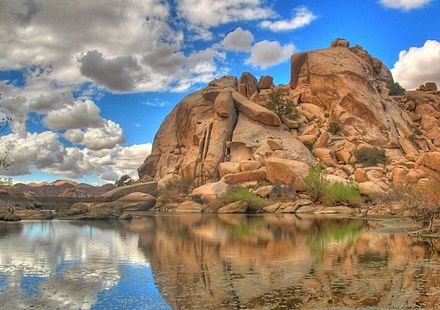
- Barker Dam, 34.0308°, -116.1461°. Built in the early 1900s to hold water for cattle and mining use, today the area is a rain-fed reservoir attracting local wildlife. Listed on the National Register of Historic Places.
- Cholla Cactus Garden (Jumping Cholla Patch), Pinto Basin Rd (15 miles / 24 km south of Twentynine Palms entrance; 20 miles / 32 km north of Cottonwood Visitor Center; 1.5 mile / 2.4 km west of Ocotillo Patch), 33.9253°, -115.9289°. A short walk leads through a thick stand of cholla cactus, noted for its especially prickly exterior. Near the transition between the Colorado and Mojave Deserts. Site includes a short 0.25 mi / 0.4 km loop trail through the patch.
- Cottonwood Springs. A desert oasis that offers a respite from the arid lands around it. Willows and birds are found in abundance near this natural spring.
- Hidden Valley, 34.013847°, -116.170508°. In the north of the park, a short trail leads through boulders to an old cattle rustler's hideout.
- Jumbo Rocks. One of the most popular and sought-out destinations in the park. Known for its spectacular giant rock formations. Hidden canyons abound. Hiking encouraged, especially the easy-to-moderate trail to Skull Rock. Campsites available. Includes an amphitheater where Park Rangers led science and history tours.
- Keys View, 33.9267°, -116.1874°. This overlook, with an elevation of 5,185 feet (1,580 m) above sea level, is an extremely popular spot for watching the sunset. Views of Coachella Valley and the San Andreas Fault. On rare clear days the view extends over the Salton Sea and Signal Mountain in Mexico.
- Geology Tour Road, 34.006°, -116.085°. 18 mile dirt road. Four-wheel drive vehicles are recommended (but not always necessary, check with rangers). This route provides more fascinating landscapes and geologic formations, with access to scenic pullouts, a few hiking trails, and some climbing access routes. (AllTrails map).
- Ocotillo Patch, Pinto Basin Rd (16 miles / 26 km south of Twentynine Palms entrance; 18 miles / 29 km north of Cottonwood Visitor Center; 1.5 mile / 2.4 km east of Cholla Patch), 33.926°, -115.904°. Interpretive display explaining how the alluvial fan supports more plants in such a narrow band of the desert floor.
Do
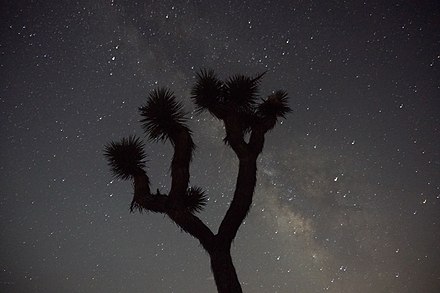
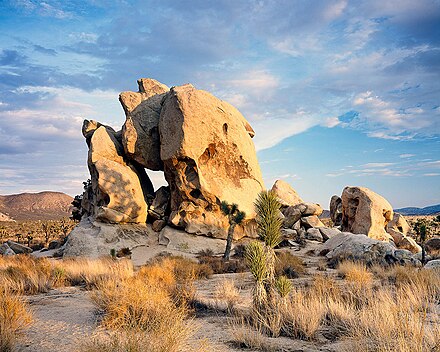
Astronomy and star gazing
Due to its dark nighttime skies and the relative clarity of its air, Joshua Tree National Park is a popular spot for amateur astronomy, stargazing, and astrophotography.
The east side of the park offers the darkest skies for stargazing. Looking east, the closest major city is Phoenix, over 250 miles (400 km) away.
Birding
The park is an attractive place to sight and watch birds. The sparse desert vegetation makes birding easier than in most national parks.
The majority of recorded bird species are migrants and vagrants. The aquatic areas of Barker Dam and the Desert Queen Ranch attract waterfowl that would not otherwise be seen in the desert, a way-stop to or from Salton Sea, further south.
Many southwestern desert species make Joshua Tree their home: from the roadrunner, mockingbird, verdin and cactus wren, to red-tailed hawk and American kestrel. Golden eagles regularly hunt throughout the park.
Climbing
The park is one of the most popular climbing, bouldering and highlining areas in the world with more than 8,000 climbing routes, 2,000 boulder problems, and 100s of natural gaps, offering a wide range of difficulty and ability levels. Note that there are differing regulations depending on whether a climb is being done within the designated wilderness area or not: check with a ranger for current regulations.
- Cliffhanger Guides, 61716 29 Palms Hwy; Joshua Tree (2.5 hours from either LA or San Diego), +1 209-743-8363. Custom guided rock climbing for adults and children. Gourmet food provided. Locally owned and operated.
- Joshua Tree Rock Climbing School, HCR 3034, +1 760-366-4745. 8AM-8PM. Year round rock climbing instruction, open enrollment basic to advanced classes offered weekly and customized private guiding in Joshua Tree National Park, California. All levels of climbing instruction, all ages. Groups, family outings and scouting merit badge programs. Three hours from Los Angeles and San Diego and one hour from Palm Springs, California. $85
- The Climbing Life Guides, 61117 Navajo Trl, Joshua Tree, +1 760-780-8868, info@joshuatreeclimbinglifeguides.com. 8AM-5PM. Offers rock climbing guiding and instruction in Joshua Tree National Park. They hold a permit to guide in the park and hire certified guides as their instructors and guides. They are a local climber-owned and -operated business. They also have a rental space available for rent for those interested in staying overnight near the park entrance in a stand-alone casita. 2015-12-11
Hiking
A great place to go! Trails within the park include short and easy to strenuous:
- Barker Dam Loop Trailhead, 34.0251°, -116.1421°. (1.1 mi / 1.8 km loop; 50 ft / 15 m elevation gain; NPS rating: short). Explore cultural history of early cattle ranchers and the water tank they built; watch for bighorn sheep. (AllTrails map).
- Boy Scout Trail, north trailhead (Indian Cove backcountry board), 34.1131°, -116.1556°. – Boy Scout Trail, south trailhead (Boy Scout Trailhead), 34.0411°, -116.1857°. (8 mi / 12.9 km one way; 1190 ft / 360 m elevation gain; NPS rating: challenging). A scenic trail through the edge of the Wonderland of Rocks. (AllTrails map).
- Cap Rock, 33.9892°, -116.1634°. – Also walk around Cap rock itself.
- Cottonwood Spring Trail, 33.7377°, -115.8111°. (1.1 mi / 1.8 km loop; 25 ft / 8 m elevation gain; NPS rating: short). A short walk to fan palm oasis with cottonwood trees; great birding location with shade. (AllTrail map).
- Fortynine Palms Oasis Trailhead (49 Palms Oasis), Canyon Rd, Twentynine Palms Highway (from CA 62 in Twentynine Palms, south on Canyon Rd, east on Fortynine Palms Canyon Rd to parking lot and trailhead), 34.1192°, -116.1120°. Day use only, gated at night. (3 mi / 4.8 km out and back; 300 ft / 90 m elevation; NPS rating: strenous, avoid when hot). A hike to an oasis surrounded by stands of fan palms and pools of water. (AllTrails map).
- Hidden Valley Trailhead, 34.0124°, -116.1681°. (1 mi / 1.6 km loop; 100 ft / 21 m elevation gain; NPS rating: easy). Short hike to a rock-enclosed valley rumored to have been used by cattle rustlers. (AllTrails map).
- Lost Horse Mine Trail, 33.9506°, -116.1597°. (4 mi / 6.4 km out and back; 550 ft / 170 m elevation; NPS rating: moderate). Lost Horse Mine is a popular destination for visitors looking for a moderate hike. Follows the haul road developed in the late 1800s by the miners. The summit elevation is 5,278 feet (1,609 m). – continue on longer Lost Horse Mine Loop, 33.9404°, -116.1375°. (6.5 mi / 10.5 km loop; 550 ft / 170 m elevation; NPS rating: challenging). extended route from out-and-back Lost Horse Loop (AllTrails map)
- Lost Palms Oasis Trail, 33.7374°, -115.8109°. (7.5 mi / 12 km out and back; 500 ft / 150 m elevation gain; NPS rating: strenuous). Hike across sandy washes, then down into a canyon with numerous palm stands, with a possible side trip to Victory Palms and Munsen Canyon that involves scrambling. (AllTrail map)
- Mastodon Peak Trail, 33.7417°, -115.8117°. (3 mi / 5 km loop; 375 ft / 115 m elevation; NPS rating: moderate). A trail goes past an old gold mine and offers excellent views of the Eagle Mountains and Salton Sea, with a summit elevation of 3,371 feet (1,027 m). Strenuous. (AllTrails map)
- Oasis of Mara Trail, 74485 National Park Dr; Twentynine Palms, 34.128°, -116.038°. (0.5 mi / 0.8 km loop; minimal elevation change; NPS rating: short). Short, flat loop trail with interpretive signs to introduce visitors to the history and ecology of the site. (AllTrails map).
- Ryan Mountain Trail, 34.0026°, -116.1360°. (3 mi / 5 km out and back; 1050 ft / 320 m elevation; NPS rating: challenging). Excellent views of Lost Horse, Queen, and Pleasant Valleys with a summit elevation of 5,461 feet (1,664 m). Strenuous. The trail is well-maintained and features stone steps for most of the way. (AllTrails map)
Historic sites
- Keys Ranch (Keys Desert Queen Ranch), end of Keys Ranch Road (from Hidden Valley Campground, go north 0.6 mi (0.9 km), go left at the Y-intersection, go 1.1 mi (1.8 km) to the locked gate where the tour will start), 34.046°, -116.169°. (NPS map). Tickets required 2017-12-30
- Lost Horse Mine, 33.9411°, -116.1369°. This mill was one of the more successful gold mines in the park. 2022-08-01
- Wall Street Mill. (hike to mill site: 2 mi / 3.2 km out and back; 80 ft / 25 m elevation gain). The mill was used to process gold from local mining operations. (AllTrails map) 2022-08-01
Learning
A number of classes are conducted in the park through the Joshua Tree National Park Association's Desert Institute. Classes include topics such as painting, photography, wildlife, wildflowers, and geology.
Photography
The odd shapes of the Joshua tree as well as the dramatic geology and desert scenery make the park a great place for photographers. As with many areas, photography is best in the early morning and late evening hours.
For astrophotography, the east side of the park offers the darkest skies but lacks the background of the Joshua tree due to its lower elevation. Lost Horse Valley (enroute to Keys Views) offers an abundance of Joshua trees and rock outcroppings for scene composition, but with light pollution from the Palm Springs and Twentynine Palms areas. Anywhere in the park you will also see an abundance of airplane light trails to and from the Los Angeles area.
As with most national parks, commercial photography requires a permit.
Wildflower viewing
 Springtime wildflowers come in numerous varieties and can produce extraordinarily colorful displays, especially following wet winters.
The flowers can include vast fields of flowering shrubs or tiny flowering plants right at your feet.
Springtime wildflowers come in numerous varieties and can produce extraordinarily colorful displays, especially following wet winters.
The flowers can include vast fields of flowering shrubs or tiny flowering plants right at your feet.
Blooms occur at different times at different elevations: in February at lower elevations in the Pinto Basin and around the south entrance (2,200 ft / 670 m elevation), in March and April at higher elevations such as from Lost Horse Valley (4,200 ft / 1,280 m elevation), and as late as June for higher desert regions above 5,000 ft (1,500 m).
For desert blooms at even lower elevations, consider continuing your journey to Death Valley wildflower blooms.
Buy
Services within the park are limited, but food, gas, and supplies can all be purchased just outside of the park in Twentynine Palms and Joshua Tree Village. Park visitor centers all offer bookstores selling maps, postcards, posters, and books of local interest.
Eat
There are no restaurants or stores in the park, but numerous options are available along CA 62 (north of the park) in towns such as Twentynine Palms and Joshua Tree Village, and limited nearby options along I-10 (south of the park) in Chiriaco Summit. Joshua Tree Village has a variety of cafes and restaurants. There are plenty of vegan and vegetarian options in the Village. Every Saturday, year round, the Village holds a farmers’ market. For further options, you would need to continue west from Joshua Tree Village to Yucca Valley and Pioneertown; continue far enough you'll hit Palm Springs.
Drink
Water is available from all visitor centers and a few of the campgrounds. Towns outside of the park borders offer additional options for refreshment, such as Twentynine Palms, Joshua Tree Village and Yucca Valley, all along CA 62.
Sleep
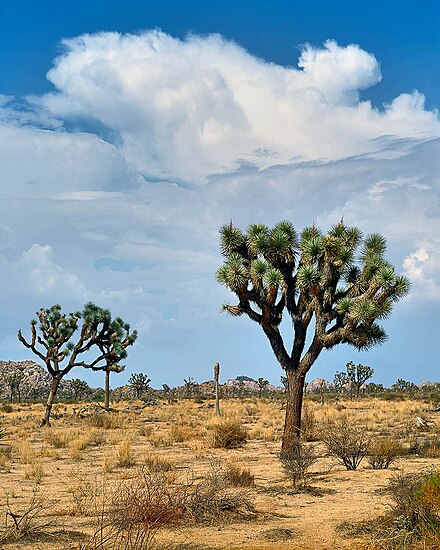
Lodging
There are no hotels within the park, but numerous hotels cluster along the Twentynine Palms highway (CA 62) in Twentynine Palms and Joshua Tree Village.
Camping
See also: California desert camping
There are nine campgrounds within the park, but they will often fill well before sunset, especially on weekends. Sadly, as least since 2005, there are no longer any free sites. All campgrounds are open year-round. Some of the campgrounds must be reserved in advance through the National Park Service Reservation System. There are also 13 staging areas for backcountry camping trips in the park; these are free but require registration in advance.
- Belle Campground, 34.0020°, -116.0196°. 18 sites. All sites are first-come, first-serve. This small (18 site) campground is at an elevation of 3,800 ft (1,160 m). Pit toilets. No water so bring plenty of your own. Belle is a great campground to see dark night skies. $15 Campsite Fee (2020 rates) 2020-06-28
- Black Rock Campground, 34.0731°, -116.3909°. 99 sites. This large (99 site) campground is in the northwest corner of the park, but it is not accessible from the main park roads. Each campsite has a picnic table and fire ring with rest rooms and water nearby. Shopping facilities are only five miles away in the town of Yucca Valley. Campsites vary in size and can accommodate both tents and RVs. A day-use picnic area and a dump station are also available. For horse owners, a separate area is provided for camping or for staging a ride. $20 Campsite (2020 rates) 2020-06-28
- Cottonwood Campground, 33.7450°, -115.8127°. 62 sites, 3 group sites. The Cottonwood Campground is reservations only during the busy season (September-May) and has 62 sites, potable water and flush toilets. $20 campsite fee, $40 group campsite fee (2020 rates) 2020-06-28
- Hidden Valley Campground, 34.0173°, -116.1626°. 44 sites. All sites are first-come, first-serve. The Hidden Valley Campground has pit toilets and no water. The campground is along Park Blvd and is surrounded by large boulders and Joshua Trees. Motorhomes and vehicles longer than 25 feet are not permitted. $15 Hidden Valley Campsite (2020 rates) 2020-06-28
- Indian Cove Campground, 34.0949°, -116.1594°. 101 sites, 13 group sites. This campground is not accessible from the main park roads and may be reached only via CA 62 and Indian Cove Road, between the North and West Entrance Stations. Indian Cove Road dead-ends at this secluded area. There are vault toilets and no water. Water is available there. $20 Individual Campsite at Indian Cove, $50 Group Campsite at Indian Cove (2020 rates) 2020-06-28
- Jumbo Rocks Campground, 33.991933°, -116.06238°. 124 sites. There are 124 individual/family sites in Jumbo Rocks Campground. Reservations are required during the busy season, September to May. The largest campground in the park, near the junction of the park roads in the northern part of the park. Sites are surrounded by scenic granite formations. $15 Jumbo Rocks Campsite (2020 rates) 2020-06-28
- Ryan Campground, 33.9831°, -116.1542°. 31 sites. All sites are first-come, first-serve. The campground is centrally located in the park and is adjacent to the California Riding and Hiking Trail. There are 4 designated equestrian sites and reservations are required. For more equestrian campsites, see Black Rock Campground. There is no water available at Ryan Campground. There are 3 bicycle sites available at $5 per night, with no more than 3 tents and 3 people per campsite. $15 Ryan Individual Campsite (2020 rates) 2020-06-28
- Sheep Pass Group Campground, 34.0002°, -116.1203°. Sheep Pass Group Campground has 6 group campsites and is easily accessible to hiking trails and rock climbing routes. All campsites are by reservation only. It is one of three group campgrounds in the park. Towering rock formations and uniquely-shaped Joshua trees surround the facility. There is no water available in the campground. $50 Group Campsite at Sheep Pass (2020 rates) 2020-06-28
- White Tank Campground, 33.9857°, -116.0167°. 15 sites. All sites are first-come, first-serve. White Tank Campground is nestled among immense granite boulders. RVs and trailers may not exceed a combined maximum length of 25 feet. There is no water available, bring plenty. White Tank has excellent night sky viewing and is near the darkest section of the park. $15 Individual Campsite at White Tank (2020 rates) 2020-06-28
Backcountry
Permits are required for all backcountry camping and can be obtained at the visitor centers. Backcountry campsites must be located at least one mile from the road and 500 feet from any trail. Camping in washes is not recommended due to possible flash flood danger. All water must be carried in as natural water sources are limited and reserved for the local wildlife population. Open fires are also forbidden, and all cooking should be done over portable camp stoves.
Stay safe
See also: Arid region safety
By far, the greatest danger in this park is the weather. Due to the high desert environment, it will be blazing hot during the day and temperatures may drop to freezing during the night. Top medical issues for visitors include both hyperthermia (body temperature too hot) and hypothermia (body temperature too cold).
Do not hike without adequate water. One gallon per person per day is the minimum recommended amount. Wear sunscreen, dress in layers, and take all other precautions when dealing with a desert environment. Be aware that even a tiny amount of rain can cause flash flooding; avoid canyons and drainage areas during severe weather.
Other dangers within the park include rattlesnakes, abandoned mines, and the numerous prickly and thorny desert plants. In general, snakes can be avoided by being careful when in rocky areas. Mines can be found throughout the park, and while most have been sealed over, open mines can still be found. Do not enter mines: most of these areas are over 100 years old and are extremely dangerous.
Flash flooding can quickly occur in low-lying areas, even if it's not raining in the immediate vicinity. Get out quickly, no matter if you are on foot or in a vehicle.
If you are going a significant distance on any of the unpaved roads, phone a friend who is not part of your party and tell them where you are going, when you will be back, when you will phone them again to tell them you are safe. Provide them with emergency numbers to call: +1 909-383-5651 (park dispatch).
There is no cellular phone service throughout most of the park. Where there is service, it is patchy and unreliable as with most wilderness and remote areas, so don't count on being able to use it in an emergency. You may be able to call 911 from some locations, but there is no guarantee. However, in an emergency always try 911: even if you have no service it may connect with another carrier.
If using maps on your phone, download maps before you go. Take a paper map with you – and know how to read it.
Go next
- Salton Sea, south — California's largest lake, formed when an irrigation canal burst in 1905 and flooded the Salton Basin for more than a year. This unusual area is home to geothermal features, a wildlife refuge, the partially built resort community of Salton City, and the "profoundly strange" artwork of Salvation Mountain in the squatter town of Slab City.
- Twentynine Palms, north — On the park's northern boundary, this small city has lodging, food and supplies for park visitors, and is home to the largest US Marine Corps Base.
- Joshua Tree Village, north — Also on the park's northern boundary, this small town also has lodging, food and supplies for park visitors.
- Palm Springs, west — A desert oasis southwest of the park, Palm Springs offers resorts, golfing, dining, and other escapes for travelers.
- Mojave National Preserve, north — Sand dunes, mountain ranges, and mesas with three types of deserts: the Mojave, Great Basin, and Sonoran; in the Mojave Desert north of Joshua Tree.
- Death Valley National Park, north — Yet another desert landscape, with the lowest elevation in the Western Hemisphere and hottest recorded temperature; further north of Mojave National Preserve.
Related: United States National Parks
Related: Twentynine Palms
Related: Joshua Tree
Related: Salton Sea
Related: Palm Springs
Related: San Bernadino County
Related: Riverside County
Joshua Tree National Park
nps.gov/jotr/index.htmRiverside County
2nd-order administrative division
California
Primary administrative division
United States
usa.govPopulation:327.2 MDial code:+1Currency:Dollar (USD)Voltage:120 V, 240 V, 60 HzNEMA 14-30NEMA 14-50